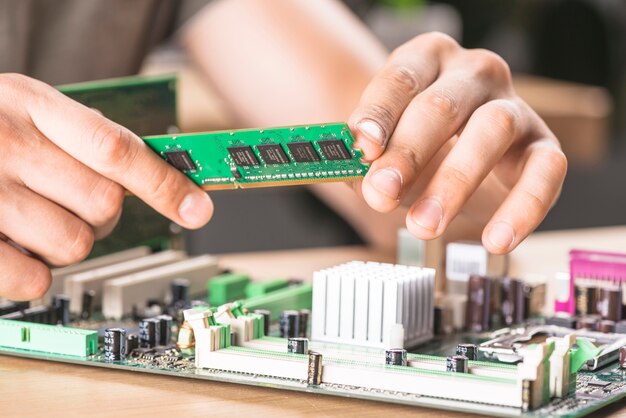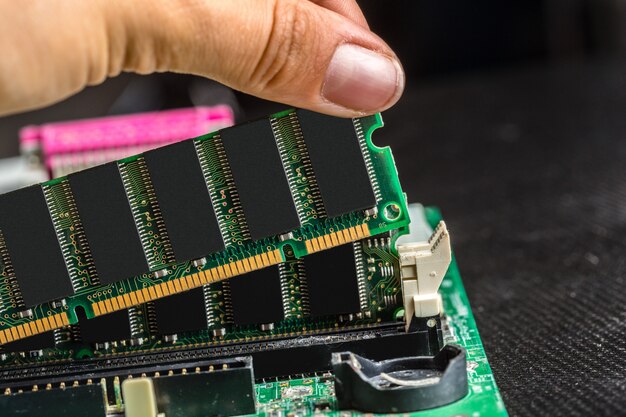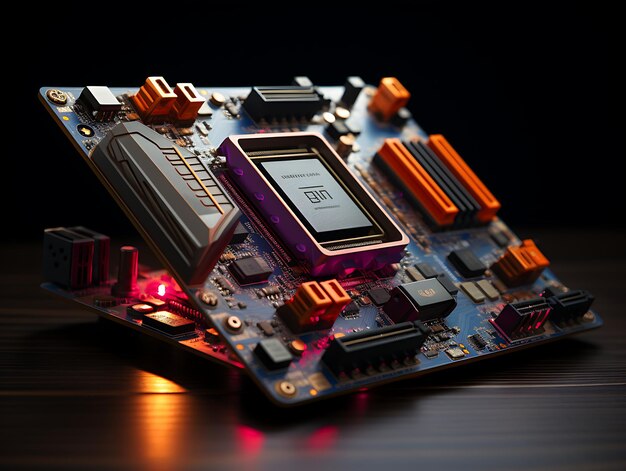I once asked, “Can a GPU not work with a motherboard?” When I built my first PC, I worried if the graphics card would fit or work well. From my experience, checking the GPU size, power needs, and slot type helps to avoid any problems.
A GPU can be incompatible with a motherboard if the slot type, power needs, or size doesn’t match. Make sure the GPU fits the PCIe slot, has enough power supply, and enough space inside the case for smooth installation.
In this article, we will discuss how to check if a GPU is compatible with a motherboard. We’ll cover key factors like slot types, power needs, and size requirements to help you choose the right GPU for your system.
What Is a GPU?
A GPU, or Graphics Processing Unit, is a dedicated processor that speeds up the process of creating and displaying images and graphics. It plays a vital role in tasks like gaming, video editing, and 3D rendering. Modern GPUs are built to handle intense graphical computations that a standard CPU can’t manage.
What Is a Motherboard?
The motherboard is the main circuit board of a computer. It connects all the components, such as the CPU, RAM, storage devices, and GPU, allowing them to communicate and work together. It’s essentially the “backbone” of a computer system.
Understanding Compatibility: GPU and Motherboard
Before diving into specific compatibility issues, it’s crucial to understand what makes a GPU compatible or incompatible with a motherboard. Consider these important points:
1. PCIe Slot Version
The PCIe (Peripheral Component Interconnect Express) slot is where the GPU is installed on the motherboard. Both the motherboard and GPU must have compatible PCIe versions. Most modern GPUs use PCIe 3.0 or 4.0 slots. However, they are usually backward compatible, meaning a PCIe 4.0 GPU can work with a PCIe 3.0 slot, but with some performance limitations.
2. Physical Size of the GPU
One common compatibility issue is the physical size of the GPU. Some GPUs are too large to fit into certain cases or motherboards. For example, if you have a compact motherboard (like a Mini-ITX), a large GPU might block other components or even be impossible to fit.
3. Power Requirements
GPUs can consume a lot of power. If your motherboard and power supply unit (PSU) do not provide enough power through PCIe connectors, the GPU will not function correctly. Ensuring your PSU can handle the GPU’s power requirements is crucial.
4. BIOS Compatibility
Some GPUs may not be recognized by a motherboard due to BIOS compatibility issues. It’s always a good idea to update your motherboard’s BIOS to the latest version before installing a new GPU.
5. SLI and Crossfire Support
If you’re planning to use multiple GPUs, ensure your motherboard supports NVIDIA SLI or AMD Crossfire technology. Not all motherboards are built to support multi-GPU setups, and this could cause compatibility problems.

Common Compatibility Issues Between GPU and Motherboard
Let’s explore some real-world scenarios where a GPU might be incompatible with a motherboard:
1. GPU Too Large for the Case
One of the most common issues is physical size. Large GPUs might not fit in smaller cases, especially if the motherboard has limited space around the PCIe slot. Always measure the available space in your case before buying a GPU.
2. Insufficient Power Supply
A motherboard with an underpowered PSU or incorrect power connectors can cause the GPU to fail to operate. Always ensure that your PSU has the necessary wattage and the right type of PCIe power connectors.
3. No PCIe x16 Slot
While most modern motherboards come with at least one PCIe x16 slot, some older or very compact models may not. In such cases, installing a modern GPU would be impossible.
4. Old Motherboard with Incompatible BIOS
Older motherboards may not have the necessary BIOS updates to support newer GPUs. This can result in the GPU not being recognized or causing the system to fail to boot.
5. Incompatibility Due to Different PCIe Standards
While PCIe slots are backward compatible, the performance may suffer if a high-performance GPU is paired with an older PCIe version motherboard. This is not a direct incompatibility but more of a performance issue.
Steps to Ensure GPU Compatibility with Your Motherboard
1. Check PCIe Slot Compatibility
Verify that your motherboard has a compatible PCIe slot (usually x16) that can accommodate the GPU.
2. Measure Available Space
Before buying a GPU, check the dimensions and compare them with the available space in your PC case and around the PCIe slot on your motherboard.
3. Power Supply Check
Make sure your PSU meets the power requirements for your GPU and has the correct PCIe power connectors.
4. BIOS Update
Ensure that your motherboard’s BIOS is updated to the latest version to avoid compatibility issues with modern GPUs.
5. Consult the Manufacturer
Always check the motherboard and GPU manufacturer’s websites for compatibility information, or contact their support teams if unsure.
How do you test a motherboard for compatibility with a new graphics card?
To check if a new graphics card is compatible with your motherboard:
- Check Physical Fit: Ensure your motherboard has a PCIe x16 slot and that the GPU will fit inside the case.
- Power Requirements: Verify that your PSU has the necessary power connectors and wattage for the GPU.
- Update BIOS: Make sure your motherboard’s BIOS is up-to-date for compatibility with the new GPU.
- Install and Test: Install the GPU, boot the system, and check for display output. Install drivers and run stress tests to ensure stability and performance.
These steps will help confirm compatibility and functionality.
How do you tell if a GPU will fit?
To see if a GPU will fit:
- Check Case Specs: Look up your case’s maximum GPU length and size limits.
- Measure Space: Measure from the PCIe slot to any obstructions in your case.
- Compare Sizes: Compare the GPU’s dimensions with the available space.
- Consider Clearance: Ensure there’s space around other components and for power connectors.
- Check Slots: Make sure there’s enough room if the GPU takes up more than one slot.
These steps will help you confirm if the GPU will fit in your case.
Understanding Gpu And Motherboard Compatibility?
To ensure GPU and motherboard compatibility:
- Slot Type: The motherboard must have a PCIe x16 slot, which is standard for modern GPUs.
- Size Fit: The GPU should physically fit into the case and motherboard space without blocking other components.
- Power Supply: Ensure the PSU has enough wattage and the right power connectors for the GPU.
- BIOS/UEFI Compatibility: Update the motherboard BIOS to support newer GPUs if necessary.
- Avoid Bottlenecks: Pair the GPU with a CPU that can match its performance level to avoid bottlenecks.
These factors will help determine if a GPU is compatible with your motherboard.
Physical Interface Compatibility?
PCIe Slot: The motherboard needs to have a PCIe x16 slot to support the graphics card.
Size Fit: The GPU must physically fit in the case, considering its length, width, and height.
Slot Space: Ensure there are enough adjacent slots if the GPU is dual- or triple-slot wide.
Clearance: Check for space around other components like RAM, CPU cooler, and power connectors.
Electrical Compatibility?
Electrical compatibility for GPU and motherboard:
- Power Supply: Make sure the power supply has enough wattage to handle the load.
- Connectors: Check for required 6-pin or 8-pin connectors.
- PCIe Slot Power: Verify the slot can provide sufficient power.
These steps ensure the GPU is powered properly.
Considerations for GPU-Motherboard Compatibility?
Considerations for GPU-motherboard compatibility:
- PCIe Slot: Ensure the motherboard has a PCIe x16 slot.
- Physical Fit: Check if the GPU size fits in the case and motherboard space.
- Power Requirements: Verify PSU wattage and power connectors.
- BIOS/UEFI Update: Ensure the motherboard firmware supports the GPU.
- Avoid Bottlenecks: Pair with a compatible CPU to prevent performance issues.
These factors ensure smooth GPU-motherboard integration.
Factors Affecting Compatibility?
Factors affecting GPU-motherboard compatibility:
- PCIe Slot Type: The motherboard must have a compatible PCIe x16 slot.
- Physical Size: The GPU must fit within the case and not obstruct other components.
- Power Supply: Ensure the PSU has enough wattage and the right connectors.
- BIOS/UEFI Support: Update the BIOS if necessary to support the GPU.
- Cooling and Airflow: Check for sufficient space for cooling and airflow.
- CPU and System Bottlenecks: Match GPU performance with the CPU to avoid bottlenecks.
These factors help determine if a GPU is compatible with a motherboard.
Physical Compatibility Considerations?
Physical compatibility considerations for a GPU:
- PCIe Slot: Ensure the motherboard has a PCIe x16 slot for the GPU.
- Case Dimensions: Check that the GPU fits in the case, including length, width, and height.
- Clearance: Ensure space around other components like RAM and CPU coolers.
- Slot Space: Verify if the GPU’s size (single or multi-slot) fits without blocking other slots.
- Power Connector Space: Allow room for power connectors to be plugged in without obstruction.
Power Supply Considerations?
Power supply considerations for a GPU:
- Wattage: Ensure the PSU provides sufficient total wattage to support the GPU and other components.
- Connectors: Check for the necessary power connectors (e.g., 6-pin, 8-pin) required by the GPU.
- Power Ratings: Verify the PSU’s power ratings (e.g., 80 Plus certification) to ensure efficient and stable power delivery.
- Cable Management: Ensure cables can reach the GPU connectors without strain or obstruction.
- PSU Quality: Use a reliable PSU brand to avoid issues with power delivery and stability.

Compatibility with Multi-GPU Configurations?
For multi-GPU setups:
- Motherboard: Must support multiple GPUs and have enough PCIe x16 slots.
- Power Supply: Ensure sufficient wattage and connectors for all GPUs.
- Case Space: Check for enough room to fit multiple GPUs.
- Cooling: Ensure adequate cooling and airflow.
- SLI/CrossFire Support: Verify support for NVIDIA SLI or AMD CrossFire.
- CPU: Ensure the CPU can handle the performance boost without bottlenecking.
Future-Proofing and Upgradability?
For future-proofing and upgradability:
- Motherboard Slot: Choose a motherboard with the latest PCIe slots (e.g., PCIe 4.0 or 5.0).
- Power Supply: Opt for a PSU with higher wattage and modular cables.
- Case Space: Ensure ample space for larger future GPUs.
- Cooling: Invest in a good cooling solution for potential upgrades.
- BIOS/UEFI: Select a motherboard with regular BIOS updates and support for new technologies.
Does my motherboard support the NVIDIA RTX A6000 GPU?
PCIe Slot: Ensure your motherboard has a PCIe x16 slot, as the RTX A6000 requires this for installation.
Power Supply: Verify that your PSU provides enough wattage and has the necessary power connectors (typically 8-pin or 12-pin for the RTX A6000).
Physical Space: Confirm that your case has enough space to accommodate the RTX A6000’s size, which is a large, professional-grade card.
BIOS/UEFI: Make sure your motherboard’s BIOS/UEFI is up-to-date to support newer GPUs.
Compatibility Lists: Check the motherboard manufacturer’s website or documentation for compatibility lists or recommendations.
FAQs
Can a GPU work on any motherboard?
Most GPUs work with most motherboards if they have a compatible PCIe slot, but other factors like power and physical size also matter.
Do all GPUs fit in any case?
No, GPUs come in different sizes. Always check the dimensions of your case and compare them with the GPU’s size.
What happens if the PSU is not powerful enough for a GPU?
If the PSU doesn’t provide enough power, the GPU may not work properly or might not even start.
How to know if my motherboard supports SLI or Crossfire?
Check your motherboard’s specifications or consult the manufacturer’s website to see if it supports SLI (for NVIDIA) or Crossfire (for AMD).
Is it necessary to update BIOS when installing a new GPU?
While not always necessary, updating your BIOS is recommended to ensure full compatibility with modern GPUs.
Can a graphics card not be compatible with a motherboard?
Yes, a graphics card can be incompatible with a motherboard if:
- Slot Type: The motherboard lacks a PCIe x16 slot.
- Size: The card is too large for the case.
- Power: The PSU doesn’t provide enough wattage or connectors.
- BIOS: The BIOS needs an update for the GPU to work.
- Space: The card might block other components or fit poorly in the case.
How to check if a GPU is compatible with a motherboard?
Slot Type: Ensure the motherboard has a PCIe x16 slot.
Physical Size: Measure case space to ensure the GPU fits.
Power Supply: Check that the PSU provides enough wattage and connectors.
BIOS/UEFI: Verify the BIOS is up-to-date for GPU support.
Manufacturer Specs: Check compatibility lists on the GPU and motherboard manufacturer’s websites.
Does every motherboard support a GPU?
No, not every motherboard supports a GPU. Compatibility depends on
PCIe Slot: The motherboard must have a PCIe x16 slot for most modern GPUs.
BIOS/UEFI: Older motherboards might need a BIOS update to support newer GPUs.
Power Supply: The PSU must provide enough power and connectors for the GPU.
Physical Space: The case and motherboard must have enough space for the GPU.
Are old GPUs compatible with any motherboard?
Old GPUs are not universally compatible with all motherboards.
Slot Type: Older GPUs might use AGP or older PCI slots, which are not present on modern motherboards. Most modern motherboards use PCIe x16 slots.
BIOS/UEFI: Newer motherboards may lack support for older GPU technologies, and BIOS updates might be needed.
Driver Support: Older GPUs might not have updated drivers for newer operating systems or hardware.
Motherboard GPU compatibility checker?
To check GPU compatibility with a motherboard:
- PC Part Picker: Use it to check compatibility by entering your motherboard and GPU models
- Manufacturer Websites: Look for compatibility lists or support documents.
- Compatibility Tools: Use online tools from motherboard or GPU manufacturers.
- Forums: Check user experiences and reviews
Motherboard compatibility checker?
To check motherboard compatibility:
- PC Part Picker: Use it to build and verify component compatibility.
- Manufacturer Websites: Check for compatibility lists or tools.
- BuildMyPC: Verify compatibility between parts.
GPU compatibility with CPU?
GPU compatibility with a CPU is generally straightforward, but consider:
- Performance Balance: Ensure the CPU is powerful enough to keep up with the GPU to avoid bottlenecks.
- Motherboard Slot: The motherboard must have a compatible PCIe x16 slot for the GPU.
- Power Supply: The PSU must meet the GPU’s power requirements and have the correct connectors.
Graphics card not compatible with motherboard?
A graphics card might not be compatible with a motherboard due to:
- Slot Type: The motherboard may lack a PCIe x16 slot required for most modern GPUs.
- Physical Size: The GPU might be too large to fit in the case or obstruct other components.
- Power Requirements: The PSU may not provide enough power or the right connectors.
- BIOS/UEFI: An outdated BIOS might not support newer GPUs.
- Motherboard Features: The motherboard might not support certain GPU technologies or features.
Can any GPU fit in any motherboard?
No, not all GPUs fit in every motherboard. Compatibility depends on:
- Slot Type: The motherboard must have a PCIe x16 slot for modern GPUs.
- Physical Size: The GPU must fit in the case and not block other components.
- Power Supply: The PSU must have enough wattage and the correct connectors for the GPU.
GPU and Motherboard?
To ensure GPU and motherboard compatibility:
- Check Slot: Ensure the motherboard has a PCIe x16 slot for the GPU.
- Fit and Power: Confirm the GPU fits in the case and the PSU has enough power and connectors.
- BIOS/UEFI: Update BIOS/UEFI if needed for the GPU.
Is my motherboard compatible with CPU?
To check if your motherboard is compatible with a CPU:
- Socket Type: Ensure the CPU socket matches the motherboard socket.
- Chipset Support: Verify the motherboard’s chipset supports the CPU.
- BIOS/UEFI: Check for BIOS updates if needed for CPU compatibility.
Conclusion
Yes, a GPU can be incompatible with a motherboard due to factors like physical size, power requirements, PCIe slot version, and BIOS support. Always double-check these factors before buying a new GPU to avoid any headaches during installation.

Leave a Reply